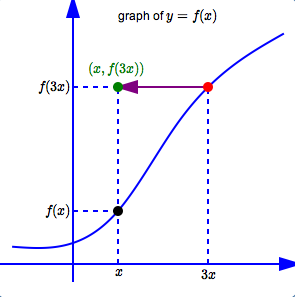 Graphing Tools: Vertical and Horizontal Scaling (Part 2)
Graphing Tools: Vertical and Horizontal Scaling (Part 2)
(This page is Part 2. Click here for Part 1.)
Ideas Regarding Horizontal Scaling (Stretching/Shrinking)
-
Points on the graph of $\,y=f(x)\,$ are of the form $\,\bigl(x,f(x)\bigr)\,.$
Points on the graph of $\,y=f(3x)\,$ are of the form $\,\bigl(x,f(3x)\bigr)\,.$
-
How can we locate these desired points $\,\bigl(x,f(3x)\bigr)\,$?

First, go to the point $\,\color{red}{\bigl(3x\,,\,f(3x)\bigr)}\,$ on the graph of $\,\color{red}{y=f(x)\,.}$ This point has the $y$-value that we want, but it has the wrong $x$-value. The $x$-value of this point is $\,3x\,,$ but the desired $x$-value is just $\,x\,.$
Thus, the current $\,\color{purple}{x}$-value must be divided by $\,\color{purple}{3}\,$; the $\,\color{purple}{y}$-value remains the same. This gives the desired point $\,\color{green}{\bigl(x,f(3x)\bigr)}\,.$
Thus, the graph of $\,y=f(3x)\,$ is the same as the graph of $\,y=f(x)\,,$ except that the $x$-values have been divided by $\,3\,$ (not multiplied by $\,3\,,$ which you might expect).
Notice that dividing the $x$-values by $\,3\,$ moves them closer to the $y$-axis; this is called a horizontal shrink.
-
Transformations involving $\,x\,$ do NOT work the way you would expect them to work! They are counter-intuitive—they are against your intuition.
-
Here is the thought process you should use when you are given the graph of $\,y=f(x)\,$ and asked about the graph of $\,y=f(3x)\,$:
interpretation of new equation:
$$ \cssId{s21}{y = f( \overset{\text{replace $x$ by $3x$}}{\overbrace{ \ \ 3x\ \ }}} ) $$-
Replacing every $\,x\,$ by $\,3x\,$ in an equation causes the $x$-values in the graph to be DIVIDED by $\,3\,.$
Summary of Horizontal Scaling
Let $\,k\gt 1\,.$ Start with the equation $\,y=f(x)\,.$ Replace every $\,x\,$ by $\,kx\,$ to give the new equation $\,y=f(kx)\,.$
This causes the $x$-values on the graph to be DIVIDED by $\,k\,,$ which moves the points closer to the $y$-axis. This is called a horizontal shrink.
A point $\,(a,b)\,$ on the graph of $\,y=f(x)\,$ moves to a point $\,(\frac{a}{k},b)\,$ on the graph of $\,y=f(kx)\,.$
Additionally: Let $\,k\gt 1\,.$ Start with the equation $\,y=f(x)\,.$ Replace every $\,x\,$ by $\,\frac{x}{k}\,$ to give the new equation $\,y=f(\frac{x}{k})\,.$
This causes the $x$-values on the graph to be MULTIPLIED by $\,k\,,$ which moves the points farther away from the $y$-axis. This is called a horizontal stretch.
A point $\,(a,b)\,$ on the graph of $\,y=f(x)\,$ moves to a point $\,(ka,b)\,$ on the graph of $\,y=f(\frac{x}{k})\,.$
This transformation type is formally called horizontal scaling (stretching/shrinking).
Different Words Used to Talk About Transformations Involving $\,y\,$ and $\,x\,$
Notice that different words are used when talking about transformations involving $\,y\,,$ and transformations involving $\,x\,.$
For transformations involving $\,y\,$ (that is, transformations that change the $y$-values of the points), we say:
DO THIS to the previous $\,y$-value.
For transformations involving $\,x\,$ (that is, transformations that change the $x$-values of the points), we say:
REPLACE the previous $x$-values by $\ldots$
Make Sure You See The Difference!
Vertical Scaling:
going from
$\,y=f(x)\,$
to
$\,y = kf(x)\,$ for $\,k\gt 0$
Horizontal Scaling:
going from
$\,y = f(x)\,$
to
$\,y = f(kx)\,$ for $\,k\gt 0$
Make sure you see the difference between (say) $\,y = 3f(x)\,$ and $\,y = f(3x)\,$!
In the case of $\,y = 3f(x)\,,$ the $\,3\,$ is ‘on the outside’; we're dropping $\,x\,$ in the $\,f\,$ box, getting the corresponding output, and then multiplying by $\,3\,.$ This is a vertical stretch.
In the case of $\,y = f(3x)\,,$ the $\,3\,$ is ‘on the inside’; we're multiplying $\,x\,$ by $\,3\,$ before dropping it into the $\,f\,$ box. This is a horizontal shrink.